A Chapter to Study. Part 2
Description
This section is from the book "A Guide To The Wild Flowers", by Alice Lounsberry. Also available from Amazon: A Guide to the Wild Flowers.
A Chapter to Study. Part 2
When the parts of the Calyx or Corolla are united, the terms used to express their different forms are:
Salver-Shaped: when the border is flat and spread out at right angles from the top of the tube. (Fig. 13.)
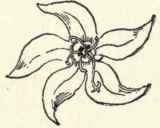
Fig. 14.

Fig. 15.
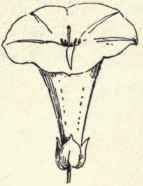
Fig. 16.

Fig. 17.
Wheel-Shaped: when the border suggests the diverging spokes of a wheel and spreads out at once, having a very short tube. (Fig. 14.)
Bell-Shaped, or Campanulate: when the tube expands towards the summit and has no border, or only a short one. (Fig. 15.)
Funnel-Formed: when the tube is narrow below, and spreads gradually to a wide border. (Fig. 16.)
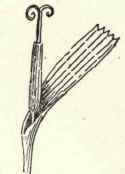
Fig. 18.
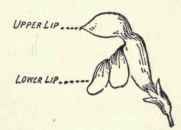
Fig. 19.
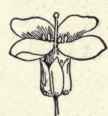
Fig. 20.
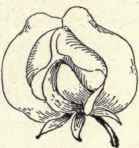
Fig. 21.
Tubular: when the tube is prolonged, and does not widen much towards the summit. (Fig. 17.)
Ligulate: when appearing strap-shaped, as in the dandelion and chicory. (Fig. 18.)
Labiate: when there is an apparently two-lipped division of the parts. In this form of corolla usually two petals grow together and make the upper lip; the remaining three petals join together and form the lower lip. These divisions appear mostly as lobes, and it is not always noticed that the flowers are of five lobes instead of two. (Fig. 19.)

Fig. 22.
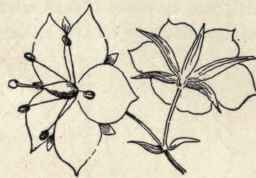
Fig. 23.
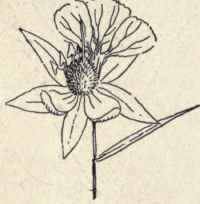
Fig. 24.

Fig. 25.
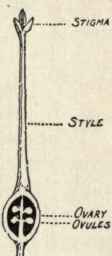
Fig. 26.
When the petals are not grown together but are wholly separate, the corolla is said to be polypetalous. Different forms are:
Rosaceous: when the petals are distinct and without claws, as in the rose.
Cruciferous: when there are four clawed petals in the form of a cross. (Fig. 20.)
Papilionaceous, or butterfly-shaped. (Fig. 21.) Such flowers are usually described in three parts: the banner, or standard, which is the large upper petal; the wings, or the two side petals, and the two anterior petals that, commonly united in a shape something like the prow of a boat and enclosing the reproducing organs, are called the keel. (Fig. 22.)
Regular Flowers are those that have the parts of each set, the sepals and petals, alike in size and form. (Fig. 23.) Irregular Flowers are the reverse of regular. (Fig. 24.)
It is sometimes found that only one set of floral leaves is present. It is then regarded as the Calyx. Collectively the floral envelope, or the protecting organs, is spoken of as the Perianth; but the word is mostly used in cases where the calyx and corolla run into each other so that it is difficult to distinguish them apart. The lily family have a perianth.
The Stamens, or Fertilizing Organs, of the plant are composed of two parts: the Filament, or stalk, which is useful to uphold the Anther; and the Anther, a tiny two-celled box which contains the Pollen. The Pollen is the yellow fertilizing powder which is the essential product of the stamens. (Fig. 25.)
Exserted Stamens are those that protrude from the corolla.
Included Stamens are those that are within the corolla.
The Pistil, or Seed-Bearing Organ, is divided into three parts: the Ovary, the Style, and the Stigma. (Fig. 26.)
The Ovary is the lower expanded part of the pistil that contains the Ovules, or undeveloped seeds. (Fig. 26.)
The Style is the slender stalk that usually surmounts the ovary. (Fig. 26.)
The Stigma is the flat or variously formed body that terminates the style. (Fig. 26.) Unlike the other organs of the plant, it is not covered by a thin skin or epidermis. Its surface is therefore moist and rough so that it readily receives and holds the pollen when it is deposited upon its surface.
Each tiny pollen grain that alights on the stigma sends out a minute tube that pierces down through the style until it reaches an ovule below, which it quickens into life. This is known as the process of Fertilization. The ovules then develop into Seeds, and the ovary enlarges into the Fruit, or Seed Vessel.
Cross-Fertilization is when the pollen of one flower is carried to the stigma of another by some extraneous agency, such as the wind or animal life.
Self-Fertilization is when the stigma receives the pollen from the stamens in the same flower-cup as itself. To prevent this catastrophe the plants are ever upon the alert, experience teaching them that the result is not good. Often either no seeds at all mature or their progeny is a weakling.
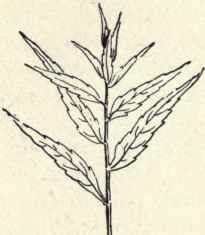
Fig. 27.

Fig. 28.
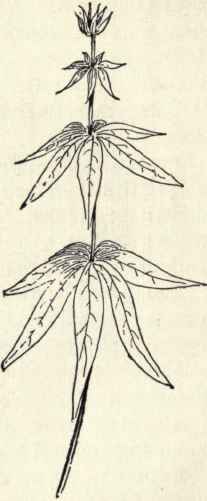
Fig. 29.

Fig. 30.

Fig. 31.
Fig. 32.
A Perfect Flower is one that has both stamens and pistil. The reverse is called an Imperfect Flower.
A Neutral Flower is one that has neither stamens nor pistils.
Staminate Flowers are those that have stamens but are without pistils.
Pistillate Flowers are those that have pistils but no stamens.
The terms male and female that are sometimes employed instead of staminate and pistillate are used wrongly and should be avoided by even those that have no pretention to botanical knowledge. It is the product of these organs and not they themselves that should be so called if the terms are used at all; but staminate and pistillate are the correct and accepted expressions.
Continue to:


